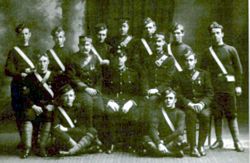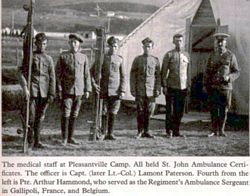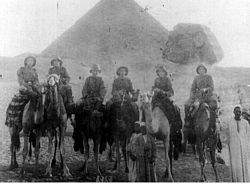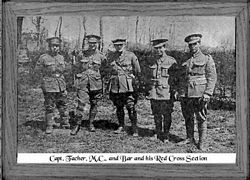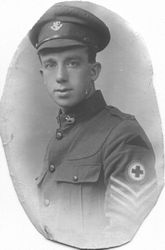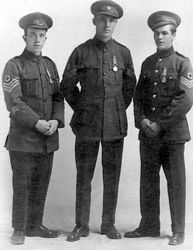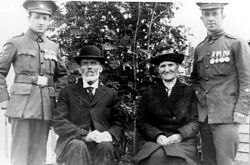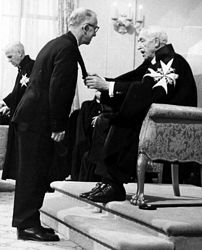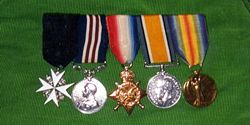NL GenWeb
Military Information
Royal Newfoundland Regiment
 Sgt. Arthur Hammond Regt #79
Sgt. Arthur Hammond Regt #79 Arthur Hammond was born on July 3, 1894 in St. John's, Newfoundland to Thomas James Hammond and Mary Elizabeth (Whitten) Hammond. A member of the Church Lads' Brigade he took his initial first aid course at age 17 from Dr. Cluny MacPherson, founder of the St. John Ambulance Association in Newfoundland. He moved to Hawkes Bay on the Northern Peninsula for about 3 years (moved permanently to Corner Brook after WWI). When WWI broke out in 1914, Arthur Hammond joined the St. John Ambulance Unit led by Dr. MacPherson. A member of of the First Contingent (known as the "the first 500"), he signed his attestation paper on October 2, 1914 and just 2 days later on October 4, left St. John's for for service abroad. They served on the front from Gallipoli and Egypt, to the Western Front.
Sgt. Hammond was one of the 1,076 Newfoundlanders who arrived on the shores with Dardanelles on September 19, 1915 to help in the Battle of Gallipoli. He survived the July 1, 1916 decimation of the Royal Newfoundland Regiment at Beaumont Hamel. Serving as a medic, he was exposed to the worst human tragedy of the battle. As noted in Colonel G. W. L. Nicholson's book "The Fighting Newfoundlander" Arthur Hammond and his staff did what they could to alleviate the suffering of the wounded before turning them over to the Royal Army Medical Corps. Later in the war, Battalion Ambulance Sergeant Hammond and 3 of his stretcher bearers *Ptes Thomas Meaney, Herber Spurrell & Patrick O'Neill were awarded the Military Medal for bravery at the Battle of Steenbeek in 1917. Sadly, Patrick O'Neill died in the Battle of Broembeek in 1917.
Sgt. A. HammondOn November 2, 1918, Captain J. Nunns submitted a report to RNR headquarters in it stating "I wish to make special report and bring to your notice 79 Sergeant. A. Hammond who had to perform the duties of Hospital Sergeant Major. Sgt Hammond worked hard day and night in performance of his duties, not only with our own men but with all the hundreds that reported to the M.O. daily ... by the end of the first week every available space on board had been turned into Hospital use ... ".
Date of Award. /8/18
Authority. Daily Orders 1st. Bn. 30/8/17
Reference. From the London Gazette, 10/10/17
"For bravery in the Field"
77th Brigade Lists.
In the attack on the enemy near Langemarck on 16th August 1917, was unfaltering in his zeal in attending the wounded and showed courageous coolness under heavy shell fire. It being mainly due to his personal efforts that the lines were swiftly cleared of the wounded. He was indefatigable in his work and inspired the wounded men with confidence by his splendid example of devotion to duty
In a December 11, 1918 letter to J. R. Bennett, Minister of Militia, Dr. Cluney MacPherson stated " ... It should be noted that Sergeant Hammond was on leave when his draft sailed and he offered to accompany it, thus foregoing leave which would have extended beyond the cessation of hostilities. Sergeant Hammond has from the very beginning of our Regiment showed this same devotion to duty. An examination of his records will, I feel certain show more trench duty to Sergeant Hammond's credit than perhaps any other man in the Regiment....".
Arthur had a brother Thomas Regt.#360, who also fought in WWI and awarded the Meritorious Service Medal, June 3, 1919. Thankfully, Thomas and Elizabeth Hammond were able to welcome both sons home after the war.
In 1923 **Dr. Kerr had a contract to provide medical services at the Paper Mill construction site in Corner Brook & the power plant in Deer Lake. Upon recommendation from Cluny MacPherson, Dr. Kerr hired Arthur Hammond to provide first aid at a station set up outside the Mill gates in Corner Brook, Dr. Kerr was stationed in Deer Lake. **Dr. Franklin Fisher supervised the first aid station, his medical practice extended from Lark Harbour to Howley a distance of 80 mines, so he only came to the first aid site when called in by Mr. Hammond. If you lived in the Corner Brook area during the mid 1920's and needed a cut sewn or a limb set, chances are it was Arthur Hammond who looked after you.
Meanwhile, a general hospital was under construction in Corner Brook to be owned and operated by the paper company. It was opened August 25, 1925 by Lady Allardyce, the wife of the Governor of Newfoundland, at that same time, the mill was officially opened. Arthur not only supplied first aid services at the mill but also worked at the hospital where he was the x-ray technician. A new hospital was built in 1951 and Arthur Hammond was it's first Administrator, a job he held until 1960.
In 1952, Arthur was instrumental in the formation of the Humber Branch of the St. John Ambulance Association in Corner Brook, a uniformed brigade was set up in 1959. His services to the St. John Ambulance were recognized by his appointment to the Order of St. John of Jerusalem. In 1951 he was admitted to the Order as a Serving Brother, promoted to Officer in 1955 and to Commander in 1964. He is mentioned in the "White Cross in Canada" on page 59, It states: "Throughout the war Ambulance Sergeant Arthur Hammond and his men tended the wounded on many a field of battle -- he won the Military Medal for his heroic work in the swamps of Flanders".
On November 7, 1981, Arthur Hammond was inducted into the Newfoundland Sports Hall of fame for his excellence as an athlete. As a youth and a member of the Church Lads' Brigade, he became actively involved in the denominational inter brigade of sports competitions which flourished locally prior to WWI. He participated in most sports but was most proficient at wrestling. In 1914, he won the featherweight wrestling championship of Newfoundland. In a span of 11 years Arthur had 4 titles in 4 different wrestling divisions, featherweight, welterweight, middleweight and lightweight. While undergoing his military training, it was noted that he excelled as a gymnast, wrestler and cross country runner and as a result was chosen as an instructor of recruits. He was a member of championship teams in football(soccer) and a trackstar in the 100-yard dash, one of his biggest wins was in Winchester England, while serving with the RNR. In 1919, he was a member of the St. Andrews soccer team which captured the St. John's championship. The same year, he was a member of the winning Army crew which captured the Veterans' race at the annual Regatta. He was a competitor in the swimming races across Quidi Vidi Lake. In 1920, he was the champion of both the welterweight and middleweight wrestling classes. He was an outstanding all-round athlete from 1909 to the late 1920's.
Arthur Hammond was married to Winifred Andrews, daughter of James Charles Andrews born in Ireland Bight and Jemima Reed of St. John's, they had 2 sons Derek (1925-1987) who settled in Stephenville, NL and David (1932-2009) made his home in Halifax, NS. Arthur did not wish to talk about his remarkable war record and the other achievements of his lifetime, he was a very humble man as were most of his generation who survived the war. Arthur Hammond passed away on January 25, 1982 in Corner Brook, Newfoundland."
| *Stretcher bearer's names from "The Fighting Newfoundlander" |
**Information about Dr. Kerr & Dr. Fisher attributed to the late Dr. Noel Murphy |
